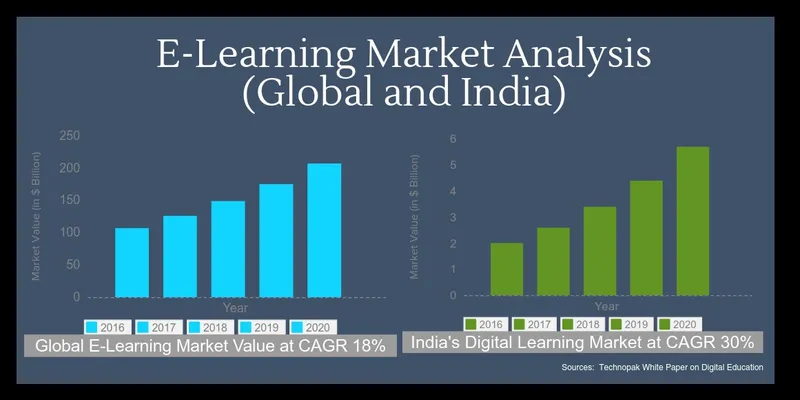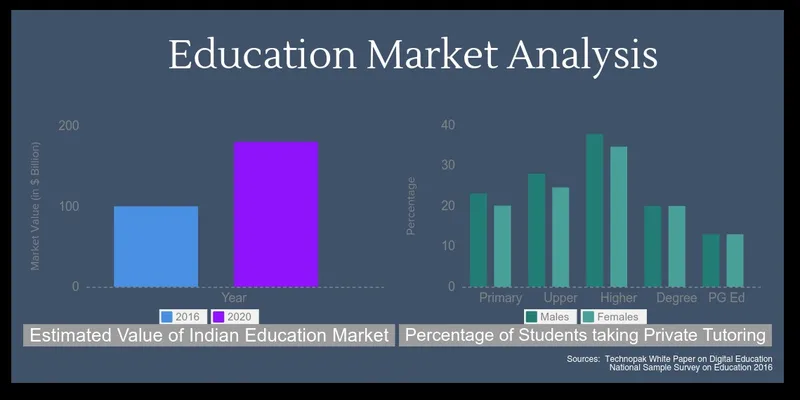

Innovations in cloud video solutions are driving EdTech growth
Online courses have become synonymous with streaming lecture videos. Inherent challenges in the video technology comprise of content piracy and smooth delivery to tier 2-3 cities. This article looks at the growth of EdTech in recent years, and how cloud video innovations are accelerating the industry.
Why has EdTech emerged as so important in 2017?
Education technology is a segment that has survived much of the volatility that has affected the year 2016-17 for startups. The recent years saw major investments in startups working in EdTech and in primary education. Byju’s, Cuemath, SimpliLearn, EduPristine, Jigsaw Academy and Avanti Learning were the most high profile education companies raising funds in last few years. Many prominent offline education institutes like TIME, Aakash, MT Educare have also ventured into online space, offering videos to both students enrolled in their classroom programs and to students who have only enrolled in the course online.
Investor sentiment for Education companies makes a lot of sense. One of the most underfunded sectors of the Indian economy (estimates suggest that under 4% of India’s GDP comes from the education sector), there is great potential for startups to leverage technology and new-age educational pedagogy. The goal is to improve education quality for millions of Indian students, be it children in the K-12 segment, college students, or young professionals looking for skill development training. When you consider the huge network of schools, colleges and career-building institutes in India, and think about how they can use technology to improve student learning, the scope of the market immediately becomes quite clear.
How has the Education landscape evolved over the last 5-10 years?
The education market has diversified considerably over the last few years - there are now specialty schools, as opposed to the binary option of pre-nursery or K-12. Likewise, online learning educators providing skill development to college students and job-seeking graduates have increased considerably.
The potential market is clearly highly segmented, with multiple entry options and multiple problems to solve. These include financing, pre-school, skill development, online education supplementing classroom learning, value addition in low-and-medium income education, ability to tap the vast pool of schools.
The promise to revolutionise home-based learning, and the fact that parents and higher education students are willing to pay for the best learning products means that the video-based learning in EdTech has vast potential for consolidation. Families prioritise education of their children, as this is one of the biggest determinants of success. In this market with varied needs, education startups have been able to find niches for themselves - whether through differentiation in content, different approaches to imparting education, or in providing technological and financial assistance for educational companies.


Industry leaders in Online Learning by Segment
K-12 - BYJUs, ClassTeacher Learning, Meritnation, MT Educare
Analytics & Big Data - Jigsaw Academy, Simplilearn, Intellipaat
Test Prep (CAT/IAS/JEE/Medical/CA) - BYJUs, TIME, OnlineTyari, PT education, Aakash, Unacademy, CAclubIndia, DrMentors
MOOCs - Udemy, Coursera, Udacity, Khan Academy
These sites and apps contribute to over 30 million Indian users in total.
How Video Has evolved to become dominant medium of education?
Most online learning companies are betting on video as the dominant knowledge delivery medium. Video is surely the closest thing to live teaching and with various animated props in action, it has an inherent portion of engagement & fun to it. Animation, Screencasting and Whiteboard lectures are the prominent tools teaching pedagogy that contribute to the content. The content is delivered online as well as offline through tablets or cards.
Another educational methodology involving videos, which is quite popular in USA but still awaits adoption in India is the pedagogical technique of flipped classroom. In this method videos are assigned to students for viewing before class. The video becomes a kind of homework, and the class succeeding it becomes a follow up in which students discuss the subjects studied. The primary learning portion becomes the homework, and the mode of teaching is flipped.

Problem of Video Piracy
As most of online geeks know, downloading and sharing videos to pirate content is quite easy with huge availability of freely available downloaders, plugins and hacks. A study found that the top 10 video download tools account for 110 million monthly users. Video downloading and sharing greatly affects the potential to generate revenues by premium course creators and undermine their efforts into content generation. The primary investment from online learning creators is in the creation of video. Since content is the primary business model for e-learning companies, video protection has become extremely critical. As an example, Byju’s has a team of 500+ people developing content.
Considering that a significant aspect of a website/app’s publicity is through informal channels such as word-of-mouth, it is possible that the content itself be shared through these informal channels, making video security all the more important.
Problems of playback in slow connections across tier 2-3 cities
The broadband & 3G/4G penetration in India still stands low at 7% & 12% of the total population respectively. Ensuring good quality course video streaming is thus a concern. Many companies still look to provide offline content through sd cards or tablets but the scalability and tracking user engagement is a major concern here.
Cloud Video Delivery technologies to the rescue
Owing to inherent technical challenges in video streaming, almost all of e-learning providers use 3rd party products to handle streaming and security. While there are many providers like YouTube, Vimeo, Wistia for video streaming, the problem of security from piracy and business customization is still not completely solved. VdoCipher, a video streaming company founded by two IIT Delhi alumni, has been providing high-end encryption & streaming solutions to top E-Learning businesses. Their client base includes 100+ E-Learning & media companies across India & 30+ countries, including some of the companies mentioned previously in the article.
Here is what Siddhant Jain, CEO, VdoCipher has to say about E-Learning companies using video to deliver learning:
“Video Lectures are definitely the primary value proposition in online courses. Because the inherent USP of a course is in its content, plus the fact that they are costly and time-consuming to produce, content protection becomes quite crucial for the content creators. They are mindful of the importance of controlling access for students for effective monetization, while at the same time are vary of not deteriorating the user experience. At VdoCipher we are committed to providing a great user experience while providing a complete Digital Rights Management solution. We have seen our top E-learning customers across India to be growing at rates of over 150% Year-Over-Year. Increasing internet penetration in India, and VdoCipher’s innovations in smooth streaming at low bitrates have helped our customers increase their market reach. I feel that it is still early days for E-Learning in India and there is lot of scope for EdTech entrepreneurs to enter the market and define their own niche.”
Internationally, there are DRM companies focusing specifically on providing enterprise-level encryption and watermarking, on top of an existing enterprise video solution. 20th Century Fox recently implemented a watermark solution from Verimatrix, which enabled them to reduce losses from piracy when videos were released for subscriber Video on Demand (SVOD) in Korea. For EdTech entrepreneurs, the packaged solution of video streaming + DRM that VdoCipher offers provides similar ability to minimize losses from piracy.
In some cases like Byju’s, companies have currently circumvented the online video streaming path majorly by providing SD cards pre-loaded with videos. They do have online playback but most of their users are based on SD card. As these videos cannot be ripped from the SD card, the technology seems to be quite secure. However Byju’s, and most e-learning companies, need to adopt the cloud quickly to be able to leverage the power of video streaming. Netflix is already pioneering this, as their superior cloud streaming technology is now being complemented by offline storage features. Netflix subscribers can now download their movies on the app for offline viewing. Similar innovations in e-learning video delivery are highly desirable.




